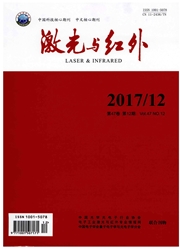

 中文摘要:
中文摘要:
考虑探测器在热冲击过程中由于传导降温非均匀引起的温度梯度分布,借助ANSYS软件对温度梯度影响下的锑化铟探测器进行热-应力耦合分析。依据热分析结果得到了热冲击下探测器的降温时间曲线,以此为基础进行热-应力耦合分析得到了探测器的应力分布,并以温度、时间为参考量将热冲击过程中InSb芯片上应力最大值变化与传统均匀降温方式下的应力最大值变化进行对比,结果表明器件内部存在温度梯度时,InSb芯片上的应力增加呈现出先快后慢现象,明显不同于均匀降温的线性增加;且应力增加主要集中在热冲击初始0~0.5 s时间段,如此短时间段内应力的急剧增加将严重影响探测器的可靠性。最后对传导降温方式下应力变化可能引起InSb芯片失效的原因进行了初步探讨,这对预测裂纹的发生提供了一定的帮助。
 英文摘要:
英文摘要:
When infrared focal plane array detector(IRFPA) is loaded by thermal shock,the temperature non-uniform in the cooling process leads to temperature gradient distribution inside the device.With the couple-field function of ANSYS,the stresses inside IRFPA influenced by temperature gradient are studied.According to the thermal analysis results the time-temperature curve is obtained.Based on the thermal analysis results,the thermal-stress coupling analysis is carried out,and the stress distribution in IRFPA is obtained.From temperature and time,the varied trends of Von Mises stress maximum in InSb chip of thermal conductive mode are compared with that of the model assuming uniform temperature distribution over the entire structure.The results show when there is the temperature gradient in IRFPA,the Von Mises stresses increase rapidly at first then slowly,which is obviously different from the Von Mises stresses changes in the model assuming uniform temperature distribution over the entire structure.The stress increase occures within a beginning time of 0 ~ 0.5s,the sharp stress increase in such a short period will severely affect the reliability of the detector.Furthermore,the reasons of InSb chip possible failure are analyzed.That will be helpful to forecast the potential fracture site in InSb chip.
 同期刊论文项目
同期刊论文项目
 同项目期刊论文
同项目期刊论文
 期刊信息
期刊信息
